Standards Worldwide
Standards Worldwide
Phone +49 30 58885700-07

Standard [CURRENT]
ASTM E 2580:2024
Standard Practice for Ultrasonic Testing of Flat Panel Composites and Sandwich Core Materials Used in Aerospace Applications
- Publication date
- 2024
- Original language
- English
- Pages
- 8
- Publication date
- 2024
- Original language
- English
- Pages
- 8
- DOI
- https://dx.doi.org/10.1520/E2580-24
Product information on this site:
Quick delivery via download or delivery service
Buy securely with a credit card or pay upon receipt of invoice
All transactions are encrypted
Short description
1.1 This practice covers two procedures for ultrasonic testing (UT) of flat panel (parallel surfaces) composites and flat sandwich core panels. Typical as-fabricated lay-ups include uniaxial, cross ply, and angle ply laminates, as well as honeycomb sandwich core materials. These procedures can be used throughout the life cycle of the materials: product and process design optimization, on line process control, after manufacture inspection, and in-service inspection. Contact methods, such as angle-beam techniques using shear waves, are not discussed. 1.2 Ultrasonic testing is a common subsurface method for detection of laminar discontinuities. Two techniques can be considered based on panel surface accessibility; pulse echo for one sided and through transmission (bubblers/squirters) for two sided. As used in this practice, both require the use of a pulsed straight-beam ultrasonic longitudinal wave followed by observing indications of either the reflected (pulse-echo) or received (through transmission) wave. The general types of anomalies detected by both techniques include foreign materials, delamination, disbond/un-bond, fiber de-bonding, inclusions, porosity, and voids. 1.3 This practice provides two ultrasonic test procedures. These test procedures can be applied to small area manual scanning and large area automated scanning. Each has its own merits and requirements for inspection and shall be selected as agreed upon in a contractual document. 1.3.1 Test Procedure A, Pulse Echo (Non-contacting and Contacting), is at a minimum a single transducer transmitting and receiving a longitudinal wave in the range of 0.5 MHz to 20 MHz (see Fig. 1 ). This procedure requires access to only one side of the specimen. This procedure can be conducted by automated or manual means. Automated and manual test results may be imaged or recorded. FIG. 1 Test Procedure A, Example Pulse Echo Apparatus Set-ups 1.3.2 Test Procedure B, Through Transmission, is a combination of two transducers. One transmits a longitudinal wave and the other receives the longitudinal wave in the range of 0.5 MHz to 20 MHz (see Fig. 2 for an example set-up using squirters). This procedure requires access to both sides of the specimen. This procedure is automated and the examination results are recorded. FIG. 2 Test Procedure B, Through Transmission Apparatus Set-up Using Squirters 1.4 This practice does not specify accept-reject criteria. 1.5 Units- The values stated in SI units are to be regarded as standard. No other units of measurement are included in this standard. 1.6 This standard does not purport to address all of the safety concerns, if any, associated with its use. It is the responsibility of the user of this standard to establish appropriate safety, health, and environmental practices and determine the applicability of regulatory limitations prior to use. 1.7 This international standard was developed in accordance with internationally recognized principles on standardization established in the Decision on Principles for the Development of International Standards, Guides and Recommendations issued by the World Trade Organization Technical Barriers to Trade (TBT) Committee.
ICS
49.035
DOI
https://dx.doi.org/10.1520/E2580-24
Also available in
Loading recommended items...
Loading recommended items...
Loading recommended items...
